Is Repairing Your 15-Year-Old Oven Worth It? A Guide to Electric Oven Troubleshooting
December 14 2024Home Heating Upgrade: Easy Ways to Keep Your House Warm and Save Money
Feeling a chill in your living room even though the thermostat says it’s on? It might be time for a home heating upgrade. In most houses, the heating system is the biggest energy user, so a smart upgrade can bring noticeable comfort and lower bills. Below are practical steps you can take right now, whether you’re thinking about a new boiler, a heat pump, or just tweaking what you already have.
Know When Your System Needs a Boost
First, take a quick look at how your current system behaves. Is the radiators slow to warm up? Do you hear strange noises from the boiler? Are you getting higher energy bills than last winter? Those are strong clues that the system is aging or not running efficiently. A simple visual inspection—checking for rust, leaks, or floating thermostat settings—can tell you a lot before you call anyone.
Pick the Right Upgrade for Your Home
There are three common routes for a heating upgrade:
- New Boiler: If your boiler is over 10‑12 years old, a modern condensing boiler can cut fuel use by up to 30 %.
- Heat Pump: For homes that can handle a bit of extra space for an outdoor unit, a heat pump offers low‑running costs and works as both heater and cooler.
- Hybrid System: Combine a smaller gas boiler with a heat pump to get the best of both worlds—quick heat when it’s freezing and efficient running when temperatures are milder.
Choosing the right path depends on your house size, insulation level, and budget. A qualified gas engineer can run a quick heat‑loss calculation to show you how much capacity you actually need.
Don’t forget to check for government incentives. Many local councils and energy companies offer rebates for installing high‑efficiency boilers or heat pumps. A quick call to your council’s energy team can reveal savings that might cover part of the upfront cost.
Once you settle on a system, the next step is picking a reputable installer. Look for Gas Safe registered engineers, read online reviews, and ask for at least three quotes. A good installer will also handle the necessary paperwork for building regulations and any warranty registration.
During the installation, keep an eye on a few practical things: the new boiler should be placed where there’s easy access for future servicing, and all ducts or pipework should be insulated to avoid heat loss. After the job is done, ask the installer to walk you through the new controls—knowing how to set the heating schedule can save you money without sacrificing comfort.
After the upgrade, regular maintenance becomes key. Schedule a boiler service at least once a year, clean the filters on heat pumps, and bleed radiators when they feel cold at the top. Simple upkeep can extend the life of your system and keep it running at peak efficiency.
Finally, think about other quick wins that complement a heating upgrade. Adding draught excluders around doors, sealing windows, and fitting thermostatic radiator valves can each shave a few percent off your heating demand. These small steps add up, making your new system work even harder for you.
Ready to start? Grab a notebook, list the signs you’ve noticed, and call a local Gas Safe engineer for a free assessment. A home heating upgrade doesn’t have to be a nightmare—it can be a smooth, cost‑saving project that keeps your house cozy for years to come.
 31 Jul
31 Jul
Should You Replace a 15-Year-Old Boiler? Essential Advice for Homeowners
Wondering if replacing a 15-year-old boiler is worth it? This guide covers the costs, efficiency, and whether a new model is the smarter choice for your home.
Read More...



